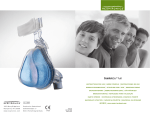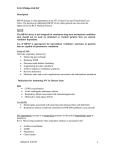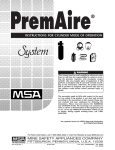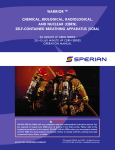Download ComfortGel Full - Philips Healthcare
Transcript
Respironics Inc. 1001 Murry Ridge Lane Murrysville, PA 15668 USA 1067744 JAW 04/08/2010 ©2010 Koninklijke Philips Electronics N.V. All rights reserved. Comfor tGel Full INSTRUCTIONS FOR USE ComfortGel Full Full Face Mask 1 Table of Contents 2 4 5 7 8 9 10 11 12 14 17 20 21 22 23 24 26 28 Package Contents Intended Use Warnings Contraindications Before Use and Disposal Symbols Cleaning Instructions Removing the Headgear from the Mask Attaching the Headgear to the Mask Achieving the Right Fit Troubleshooting Tips Removing the Mask and Headgear Tubing Quick Release Replacing the Forehead Pad Cushion and Flap Assembly Specifications Limited Warranty Reorder Information Instructions for Use 2 Package Contents •• •• •• •• Note: ComfortGel Full Face Mask -includes gel cushion and Comfort Flap with Sure Seal Technology (SST) ComfortGel Full Headgear Instructions for Use QuickStart Fitting Tips A B D C E F G J H I ComfortGel Full Not all packages contain listed items. Please contact your Home Care Provider or Respironics for additional items. Figure 1 A = Forehead Support Slots B = Forehead Bracket C = StabilitySelector D = Forehead Pad E = Exhalation Port (Do not block) F = Pick Off Port G = Entrainment Valve (inside mask elbow) H = Quick Clip I = Swivel J = Swivel Release 3 Intended Use The ComfortGel Full Face Mask is intended to provide an interface for application of CPAP or bi-level therapy to patients. The mask is for single patient use in the home and multi-patient use in the hospital/institutional environment. The mask is to be used on patients (>66lbs/30kg) who are appropriate candidates for noninvasive ventilation. Important Note: An exhalation port is built into the ComfortGel Full Face Mask so a separate exhalation port is not required. Caution U.S. Federal law restricts this device to sale by or on the order of a physician. Instructions for Use 4 Warnings •• •• This mask is not suitable for providing life support ventilation. This mask is designed for use with CPAP or bi-level systems recommended by your health care professional or respiratory therapist. Do not wear this mask unless the CPAP or bi-level system is turned on and operating properly. Do not block or try to seal the exhalation port. Explanation of the Warning: CPAP systems are intended to be used with special masks with connectors which have vent holes to allow continuous flow of air out of the mask. When the CPAP machine is turned on and functioning properly, new air from the CPAP machine flushes the exhaled air out through the attached mask exhalation port. However, when the CPAP machine is not operating, enough fresh air will not be provided through the mask, and exhaled air may be rebreathed. This warning applies to most models of CPAP systems. Rebreathing of exhaled air for longer than several minutes can, in some circumstances, lead to suffocation. ComfortGel Full Warning A warning indicates the possibility of injury to the user or operator. Caution A caution indicates the possibility of damage to the device. Note A note places an emphasis on an operating characteristic. 5 Warnings (cont.) •• If oxygen is used with the device, the oxygen flow must be turned off when the device is not operating. Explanation of the Warning: When the device is not in operation, and the oxygen flow is left on, oxygen delivered into the ventilator tubing may accumulate within the device enclosure. Oxygen accumulated in the device enclosure will create a risk of fire. •• Oxygen supports combustion. Oxygen should not be used while smoking or in the presence of an open flame. •• At a fixed flow rate of supplemental oxygen flow, the inhaled oxygen concentration will vary, depending on the pressure settings, patient breathing pattern, mask selection, and the leak rate. This warning applies to most types of CPAP and bi-level machines. •• Some users may experience skin redness, irritation, or discomfort. If this happens, discontinue use and contact your healthcare professional. •• The patient’s physician should be contacted if the patient experiences the following symptoms while using the mask or after removing it: Unusual chest discomfort, shortness of breath, stomach distension, belching, or severe headache; drying of the eyes, eye pain, or eye infections; blurred vision. (Consult an ophthalmologist if symptoms persist.) •• At low CPAP or EPAP pressures, the flow through the exhalation port may be inadequate to clear all exhaled gas from the tubing. Some rebreathing may occur. Instructions for Use 6 Warnings (cont.) •• A minimum of 3cm H2O (hPa) must be maintained when using this mask. •• This mask should not be used for patients who are uncooperative, obtunded, unresponsive, or unable to remove the mask. •• This masks is not recommended for patients who are taking a prescription drug that may cause vomiting. •• When including an additional exhalation device to the patient circuit, you may need to adjust the pressure level to compensate for the additional leak of the exhalation device. •• The gel mask is not customizable. Do not attempt to heat. •• Hand wash prior to first use. Inspect the mask. If any visible deterioration of a system component is apparent (cracking, crazing, tears or cushion damage resulting in gel exposure, etc), the component should be discarded and replaced. •• Using a mask may cause tooth, gum or jaw soreness or aggravate an existing dental condition. If symptoms occur, consult your physician or dentist. Contraindications This mask may not be suitable for persons with the following conditions: impaired cardiac sphincter function, excessive reflux, impaired cough reflex, and hiatal hernia. It should not be used if the patient is uncooperative, obtunded, unresponsive, or unable to remove the mask by themselves. ComfortGel Full 7 Symbols Symbol . Description Symbol Description Warning or Caution Does not contain natural rubber latex Note System One Resistance Control Setting Tip Consult instructions for use Instructions for Use 8 Before Use •• Hand wash the mask to remove any dust that accumulated during shipping or storage. •• Read and understand the instructions completely. •• Verify that the air entrainment valve functions correctly. •• Wash the patient’s face. •• Remove the Quick Start fitting tips (if attached to the headgear). Entrainment Valve The entrainment valve consists of an air inlet and a flapper. With the airflow turned off, verify that the elbow with the flapper is lying flat (Figure 2) so that room air can flow in and out through the air inlet. Next, with the airflow on, the flapper should now cover the air inlet and air from the CPAP or bi-level device should flow into the mask. If the flapper does not close or does not function properly, replace the mask. ComfortGel Full A B Figure 2 A = Flapper is lying flat B = Flapper is covering the air inlet Warning Do not block or try to seal the entrainment valve or the exhalation vents. 9 Cleaning Instructions Hand wash the mask before first use and daily. The headgear should be hand washed weekly, or as needed. The headgear does not need to be removed for daily cleaning of the mask. 1. Hand wash the mask and headgear in warm water with a mild liquid dish washing detergent. Caution: Do not use bleach, alcohol, cleaning solutions containing bleach or alcohol, or cleaning solutions containing conditioners or moisturizers. 2. Rinse thoroughly with drinking quality water and air dry out of direct sunlight. Make sure the mask is dry before use. 3. Lay the headgear flat or line dry. Do not place the headgear into the dryer. 4. Inspect all parts for damage or wear; replace any parts that have visibly deteriorated (cracking, crazing, tears, etc). Replace the mask if the cushion becomes hardened. For multi-patient use in the hospital/institutional environment, use the Mask Cleaning and Disinfection Instructions to reprocess the mask between patients. These instructions can be obtained by visiting www.sleepapnea.com or contacting Respironics Customer Service at 1-800-345-6443 (USA or Canada) or 1-724-387-4000. Instructions for Use 10 System One Resistance Control This mask uses the System One Resistance Control setting . This symbol may appear on your therapy device. This symbol represents the level of mask resistance compensation. Match the setting to the mask if appropriate. Important Notes: •• •• Verify the System One setting if the mask or mask cushion changes. The System One setting is not compatible with masks requiring a separate/additional exhalation device. If your provider has locked the resistance compensation setting, you can view the setting but cannot change it, and the screen will display a lock symbol. If your provider has disabled the resistance compensation, you will not see this setting. ComfortGel Full 11 Replacing the Forehead Pad The forehead pad will slide off and on the track of the forehead pad bracket (Figure 3). The forehead pad is strong and will stretch without tearing. Figure 3 G A F B E D A = Forehead Pad Tab B = Forehead Pad Slot C = StabilitySelector D = Forehead Support Arm E = Forehead Bracket F = Headgear Bracket Slot G = Forehead Pad C Note Do not detach the StabilitySelector from the faceplate rail. Instructions for Use 12 Removing and Attaching the Headgear and Mask Method 1 (Brackets): a. Removing - Undo the four headgear tabs on the headgear (Figure 4) and pull the straps out of the forehead bracket slots and on the Quick Clips. b. Reattaching - Thread the top headgear straps into the slots in the forehead bracket and the Quick Clips. The headgear tabs fold back to catch the headgear straps. Method 2 (Ball Sockets): a. Removing - Disconnect the Quick Clips and forehead support arm. Pull the Quick Clip ball up and away from the socket (Figure 5). Do not pull the ball through the socket. Next, disconnect the forehead bracket from the forehead support arm by pressing in on the center of the forehead bracket and then squeezing the upper sides of the support arm together to disengage the forehead bracket (Figure 6). ComfortGel Full Figure 4 Figure 5 Figure 6 b. Reattaching - Place the ball against the socket and gently press the ball into the socket. Press in on the center of the forehead bracket and then squeeze the upper sides of the support arm together. Slide the tabs into the forehead bracket until they latch into place. Mask Use and Fit 1. Open the headgear to a large size setting and adjust the forehead arm to the highest position. To adjust, gently squeeze the arms of the StabilitySelector and slide the arm upwards. 2. Disconnect one, or both of the Quick Clips. Place the mask cushion against the face by first setting the base of the cushion under the lower lip then roll the cushion up the nose. Be sure the mouth remains slightly open. Pull the headgear on over your head. Connect the Quick Clips if detached. 3. Using both hands, adjust the top headgear strap first by using the headgear tabs on the headgear. The forehead pad should be touching your forehead lightly. Adjust the Instructions for Use 13 14 bottom strap so that the mask is sitting gently on your face. 4. Connect the tubing that is included with your CPAP or bi-level device to the swivel elbow on the mask (Figure 7). 5. Turn on the airflow. 6. Lie down and breathe normally. Be sure the mouth remains slightly open. If the forehead pad does not rest comfortably against your forehead, Tighten the top headgear strap. If there are any air leaks make any final adjustments. Some air leakage is normal. Do not overtighten the headgear. Figure 7 Comfort Tips Adjust the StabilitySelector on the forehead support arm to reduce leaks or reduce pressure points at the bridge of the nose or above the lip. Follow these tips to adjust for leaks. •• For leaks around the bridge of the nose or into the eyes, gently squeeze the arms of the StabilitySelector and adjust to a lower position (Figure 8). ComfortGel Full Figure 8 •• For leaks around or below the mouth gently squeeze the arms of the StabilitySelector and adjust to a higher position. Re-seat the mask by pulling it directly away from the face and gently setting it back into place (Figure 9). •• The most common mistake is overtightening the headgear. The headgear should fit loose and comfortable. If your skin bulges around the mask, loosen the headgear straps. If you see red marks or the mask leaves impressions on your skin, loosen the headstraps (Figure 10). 15 Figure 9 Figure 10 Instructions for Use 16 Taking Off the Headgear and Mask To take off the mask and headgear, first remove one or both Quick Clips from the mask sockets. Grasp the body of the Quick Clip and gently pull the ball out of the socket away from your face. After the Quick Clip is disengaged, slide the mask over your face (Figure 11). By using the Quick Clip to remove your mask, you’ll be able to maintain your mask and headgear adjustments every day. Tubing Quick Release The mask elbow is equipped with a tubing quick release. Simply squeeze the quick release tabs and the blue swivel will disengage from the mask and come loose with the tubing (Figure 12). Figure 11 Figure 12 Note to Home Care Providers: If a nasogastric tube or similar device is in place, use an optional nasogastric tube sealing pad. Position the pad so that its flat surface is against the user’s face and the C-shaped opening surrounds the tube. ComfortGel Full 17 Assembling the Cushion and Flap Remove the Gel cushion by detaching the comfort flap with its integrated retaining ring from the faceplate. Do this by pressing on the faceplate tabs at the bottom of the mask. Clean or discard the cushion as necessary. First, place the Gel cushion onto the faceplate (Figure 13). Then, put the Comfort Flap over the Gel cushion and push the retaining ring onto the faceplate until the connection tabs click into place. Gently tug on the cushion to make sure all of the parts are securely in place. Figure 13 A = Mask Faceplate B = Gel Cushion C = ComfortFlap with Retaining Ring A B C Instructions for Use 18 Specifications Warning: The technical specifications of the mask are provided for your healthcare professional to determine if it is compatible with your CPAP or bi-level therapy device. If used outside these specifications, or if used with incompatible devices, the mask may be uncomfortable, the seal of the mask may not be effective, optimum therapy may not be achieved, and leak, or variation in the rate of leak, may affect device function. Intentional Leak 60.0 50.0 40.0 30.0 20.0 10.0 0.0 ComfortGel Full 19 Pressure Drop cm H 2O (hPa) 50 SLPM 100 SLPM All mask sizes: .4 1.0 Deadspace Small 260 mL Medium 280 mL Large 300 mL X-Large 320 mL Disposal Dispose of in accordance with local regulations. Storage Conditions -4º to 140º F (-20º to +60º C) 15% to 95% relative humidity, non-condensing Instructions for Use 20 LIMITED WARRANTY Respironics, Inc. warrants that its mask systems (including mask frame and cushion) (the “Product”) shall be free from defects of workmanship and materials for a period of ninety (90) days from the date of purchase (the “Warranty Period”). If the Product fails under normal conditions of use during the Warranty Period and the Product is returned to Respironics within the Warranty Period, Respironics will replace the Product. This warranty is non-transferable and only applies to the original owner of the Product. The foregoing replacement remedy will be the sole remedy for breach of the foregoing warranty. This warranty does not cover damage caused by accident, misuse, abuse, negligence, alteration, failure to use or maintain the Product under conditions of normal use and in accordance with the terms of the product literature, and other defects not related to materials or workmanship. This warranty does not apply to any Product that may have been repaired or altered by anyone other than Respironics. Respironics disclaims all liability for economic loss, loss of profits, overhead, or indirect, consequential, special or incidental damages which may be claimed to arise from any sale or use of the Product. Some states do not allow the exclusion or limitation of incidental or consequential damages, so the above limitation or exclusion may not apply to you. ComfortGel Full 21 THIS WARRANTY IS GIVEN IN LIEU OF ALL OTHER EXPRESS WARRANTIES. IN ADDITION, ANY IMPLIED WARRANTY, INCLUDING ANY WARRANTY OF MERCHANTABILITY OR FITNESS FOR A PARTICULAR PURPOSE, IS SPECIFICALLY DISCLAIMED. SOME STATES DO NOT ALLOW DISCLAIMERS OF IMPLIED WARRANTIES, SO THE ABOVE LIMITATION MAY NOT APPLY TO YOU. THIS WARRANTY GIVES YOU SPECIFIC LEGAL RIGHTS, AND YOU MAY ALSO HAVE OTHER RIGHTS, WHICH VARY FROM STATE TO STATE. To exercise your rights under this limited warranty, contact your local authorized Respironics, Inc. dealer or Respironics, Inc. at 1001 Murry Ridge Lane, Murrysville, Pennsylvania 15668, 1-800-345-6443 (USA and Canada only) or 1-724-387-4000. Instructions for Use 22 Reorder Numbers 1040135 1040136 1040137 1062004 S ComfortGel Full Face Mask w/ Headgear M ComfortGel Full Face Mask w/ Headgear L ComfortGel Full Face Mask w/ Headgear XL ComfortGel Full Face Mask w/ Headgear 1040568 1040569 1040570 1062003 S ComfortGel Full Face Mask w/o Headgear M ComfortGel Full Face Mask w/o Headgear L ComfortGel Full Face Mask w/o Headgear XL ComfortGel Full Face Mask w/o Headgear 1044861 1044862 1044863 1062032 RP S ComfortGel Full Flap and Cushion RP M ComfortGel Full Flap and Cushion RP L ComfortGel Full Flap and Cushion RP XL ComfortGel Full Flap and Cushion 1040798 1040799 1040800 1062030 RP S ComfortGel Full Face Mask Cushion RP M ComfortGel Full Face Mask Cushion RP L ComfortGel Full Face Mask Cushion RP XL ComfortGel Full Face Mask Cushion ComfortGel Full 23 Reorder Numbers 1040795 1040796 1040797 1062031 RP S ComfortGel Full Face Mask Flap RP M ComfortGel Full Face Mask Flap RP L ComfortGel Full Face Mask Flap RP XL ComfortGel Full Face Mask Flap 1040138 1040139 1040114 1049398 RP ComfortGel Full Headgear RP Mushroom Swivel Clips, Blue RP Silicone Pillow Forehead Pad RP ComfortGel Full Entrainment Valve, Swivel, Blue Instructions for Use 24 ComfortGel Full





































